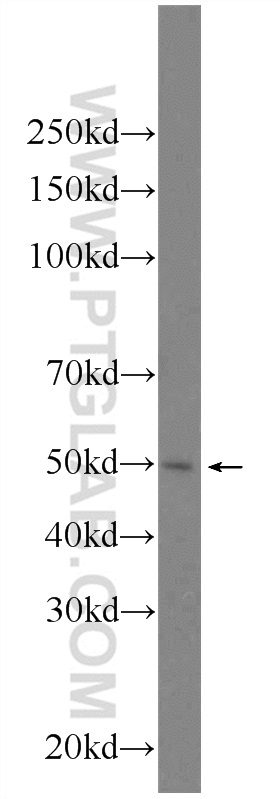验证数据展示
经过测试的应用
| Positive WB detected in | HeLa cells |
推荐稀释比
| 应用 | 推荐稀释比 |
|---|---|
| Western Blot (WB) | WB : 1:200-1:1000 |
| It is recommended that this reagent should be titrated in each testing system to obtain optimal results. | |
| Sample-dependent, Check data in validation data gallery. | |
产品信息
24560-1-AP targets FYTTD1 in WB, ELISA applications and shows reactivity with human samples.
| 经测试应用 | WB, ELISA Application Description |
| 经测试反应性 | human |
| 免疫原 | FYTTD1 fusion protein Ag20051 种属同源性预测 |
| 宿主/亚型 | Rabbit / IgG |
| 抗体类别 | Polyclonal |
| 产品类型 | Antibody |
| 全称 | forty-two-three domain containing 1 |
| 别名 | FYTTD1, Protein 40 2 3, UAP56 interacting factor, UIF |
| 计算分子量 | 318 aa, 36 kDa |
| 观测分子量 | 50 kDa |
| GenBank蛋白编号 | BC039734 |
| 基因名称 | FYTTD1 |
| Gene ID (NCBI) | 84248 |
| RRID | AB_2879609 |
| 偶联类型 | Unconjugated |
| 形式 | Liquid |
| 纯化方式 | Antigen affinity purification |
| UNIPROT ID | Q96QD9 |
| 储存缓冲液 | PBS with 0.02% sodium azide and 50% glycerol , pH 7.3 |
| 储存条件 | Store at -20°C. Stable for one year after shipment. Aliquoting is unnecessary for -20oC storage. |
背景介绍
FYTTD1 also termed as UAP56 interacting factor or UIF is a 318 amino acid protein, which belongs to the UIF family. FYTTD1 localizes to nucleus and is required for mRNA export from nucleus to cytoplasm. Functioning as an adaptor, FYTTD1 utilizes the BAT1/DDX39-TAP pathway, which is essential for efficient mRNA export and nuclear pore delivery. FYTTD1 interacts with SSRP1, a protein that is necessary for its recruitment of mRNAs, in addition to a mutually exclusive interaction with BAT1/DDX39 and TAP. The molecular weight of post-translation modified FYTTD1 is observed 50 kDa.
实验方案
| Product Specific Protocols | |
|---|---|
| WB protocol for FYTTD1 antibody 24560-1-AP | Download protocol |
| Standard Protocols | |
|---|---|
| Click here to view our Standard Protocols |
